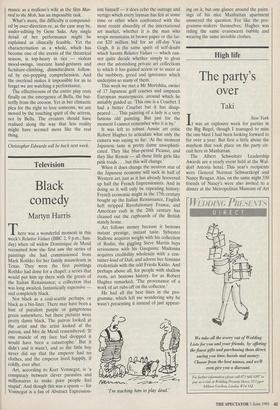Television
Black comedy
Martyn Harris
There was a wonderful moment in this week's Relative Values (BBC 2, 9 p.m., Sun- day) when oil widow Dominique de Menil recounted how she first saw the series of paintings she had commissioned from Mark Rothko for her family mausoleum in Texas. They were the first paintings Rothko had done for a chapel: a series that would put him up there with the greats of the Italian Renaissance; a collection that was long awaited, fantastically expensive and completely black.
Not black as a coal-scuttle perhaps, or black as a bin-liner. There may have been a hint of purulent purple or gangrenous green somewhere, but these pictures were pretty damn black. The patron looked at the artist and the artist looked at the patron, and Mrs de Menil remembered: 'If one muscle of my face had dropped it would have been a catastrophe.' But it didn't and it wasn't, and so the little boy never did say that the emperor had no clothes, and the emperor lived happily, if coldly, ever after.
Art, according to Kurt Vonnegut, is 'a conspiracy between clever parasites and millionaires to make poor people feel stupid'. And though this was a spasm — for Vonnegut is a fan of Abstract Expression- ism himself — it does echo the outrage and vertigo which every layman has felt at some time or other when confronted with the most recent absurdity of the international art market, whether it is the man who wraps mountains in brown paper or the lat- est $20 million bid for an off-day Van Gogh. It is the same spirit of self-doubt which haunts Relative Values — which can- not quite decide whether simply to gloat over the astonishing private art collections to which it has gained access or to sneer at the snobbery, greed and ignorance which underpins so many of them.
This week we met a Mr Morishita, owner of 17 Japanese golf courses and umpteen European masterpieces, around which he amiably guided us. 'This one is a Courbet. I had a better Courbet but it has disap- peared . . . This painting of a lady is a very famous old painting. But just for the moment I cannot remember who it is by.'
It was left to robust Aussie art critic Robert Hughes to articulate what only the camera was saying so far: 'At the moment Japanese taste is pretty damn unsophisti- cated. They like blue-period Picasso, and they like Renoir — all those little girls like pink toads . . . but this will change.'
When it does change the neutron star of the Japanese economy will suck in half of Western art, just as it has already hoovered up half the French Impressionists. And in doing so it will only be repeating history: French economic might in the 17th century bought up the Italian Renaissance, English heft stripped Revolutionary France, and American cash in the 20th century has cleaned out the cupboards of the British stately home. Art follows money because it bestows instant prestige, instant taste. Sylvester Stallone acquires weight with his collection of Rodin; the giggling Steve Martin buys seriousness with his Gauguins; Madonna acquires credibility wholesale with a con- tainer-load of Dali, and adorns her feminist credentials with the odd Frieda Kahlo. And perhaps above all, for people with shallow roots, art bestows history, for as Robert Hughes remarked, 'The provenance of a work of art rubs off on the collector.'
He had all the best lines in the pro- gramme, which left me wondering why he wasn't presenting it instead of just appear- 'I'm teaching him to play dead.' ing on it, but one glance around the paint- ings of his nice Manhattan apartment answered the question. For like the pro- gramme-makers themselves, Hughes was riding the same evanescent bubble and wearing the same invisible clothes.


















































 Previous page
Previous page